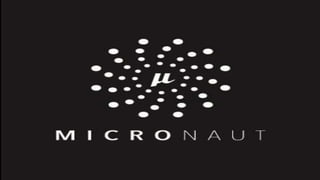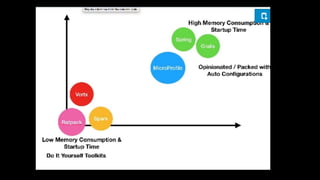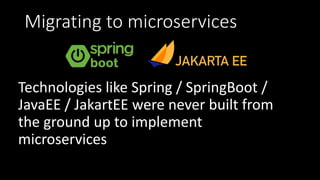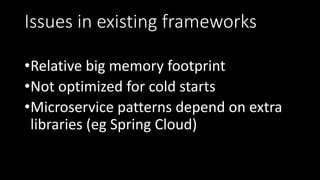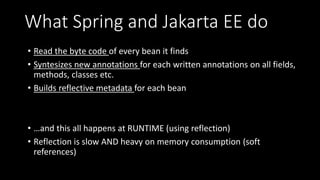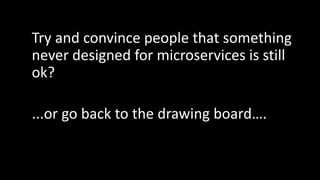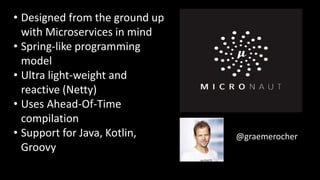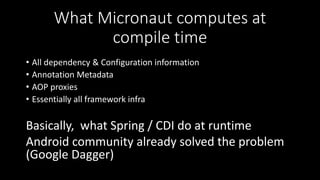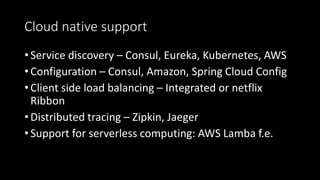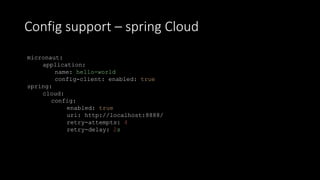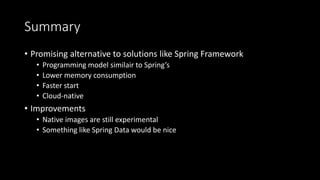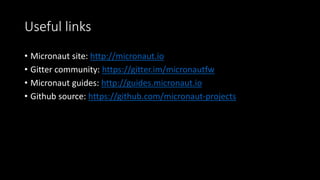Micronaut brainbit
- 3. Migrating to microservices Technologies like Spring / SpringBoot / JavaEE / JakartEE were never built from the ground up to implement microservices
- 4. Issues in existing frameworks •Relative big memory footprint •Not optimized for cold starts •Microservice patterns depend on extra libraries (eg Spring Cloud)
- 5. • Read the byte code of every bean it finds • Syntesizes new annotations for each written annotations on all fields, methods, classes etc. • Builds reflective metadata for each bean • …and this all happens at RUNTIME (using reflection) • Reflection is slow AND heavy on memory consumption (soft references) What Spring and Jakarta EE do
- 6. Try and convince people that something never designed for microservices is still ok? ...or go back to the drawing board….
- 7. • Designed from the ground up with Microservices in mind • Spring-like programming model • Ultra light-weight and reactive (Netty) • Uses Ahead-Of-Time compilation • Support for Java, Kotlin, Groovy @graemerocher
- 8. • All dependency & Configuration information • Annotation Metadata • AOP proxies • Essentially all framework infra Basically, what Spring / CDI do at runtime Android community already solved the problem (Google Dagger) What Micronaut computes at compile time
- 10. Size / Performance •Hello word JAR is 12MB versus 40MB SpringBoot •Starts up fast •Low memory footprint (runs on as little as 10MB max heap)
- 11. Cloud native support • Service discovery – Consul, Eureka, Kubernetes, AWS • Configuration – Consul, Amazon, Spring Cloud Config • Client side load balancing – Integrated or netflix Ribbon • Distributed tracing – Zipkin, Jaeger • Support for serverless computing: AWS Lamba f.e.
- 12. Service discovery with Consul micronaut: application: name: hello-world consul: client: registration: enabled: true defaultZone: "${CONSUL_HOST:localhost}:${CONSUL_PORT:8500}" @Client(id = "hello-world") interface HelloClient{ ... }
- 13. Config support – spring Cloud micronaut: application: name: hello-world config-client: enabled: true spring: cloud: config: enabled: true uri: http://localhost:8888/ retry-attempts: 4 retry-delay: 2s
- 14. Distributed tracing @Singleton class HelloService { @NewSpan("hello-world") public String hello(@SpanTag("person.name") String name) { return greet("Hello " + name); } @ContinueSpan public String greet(@SpanTag("hello.greeting") String greet) { return greet; } } tracing: zipkin: enabled: true
- 15. Native images • GraalVM is a polyglot VM capable of running apps written in: • JVM-based languages (Java, Kotlin, Clojure, Scala • Javascript, Python, Ruby • LLVM-based languages (C, C++) • AOT compiling into native images • Micronaut supports application conversion into native image (not production ready)
- 16. Summary • Promising alternative to solutions like Spring Framework • Programming model similair to Spring’s • Lower memory consumption • Faster start • Cloud-native • Improvements • Native images are still experimental • Something like Spring Data would be nice
- 17. Useful links • Micronaut site: http://micronaut.io • Gitter community: https://gitter.im/micronautfw • Micronaut guides: http://guides.micronaut.io • Github source: https://github.com/micronaut-projects

